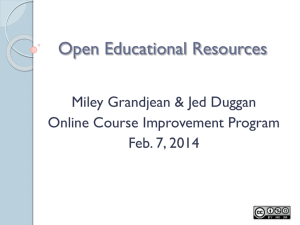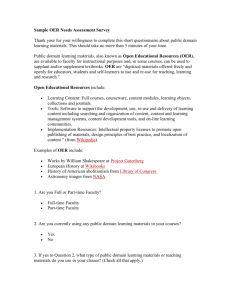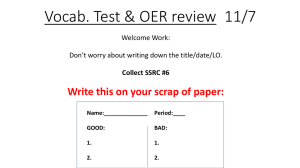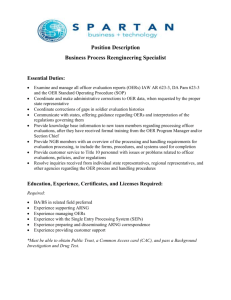Effective Use of Open Educational Resources In the Classroom Drexel University Online
advertisement
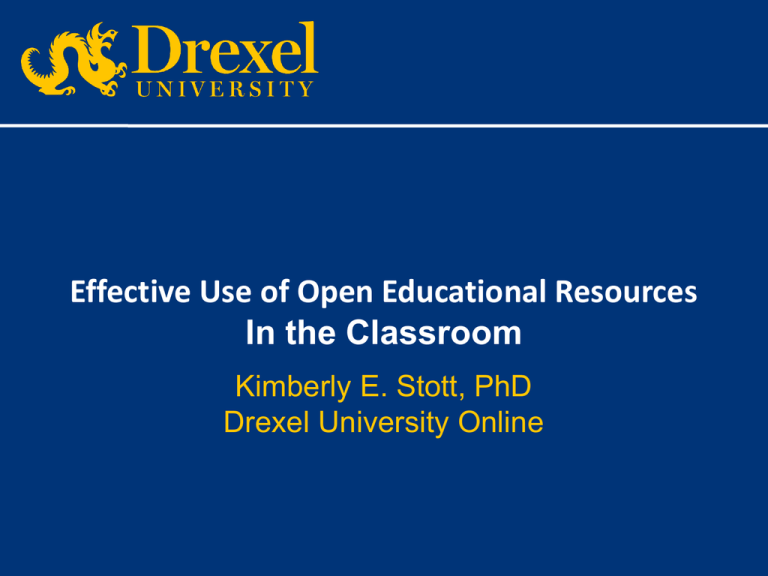
Effective Use of Open Educational Resources In the Classroom Kimberly E. Stott, PhD Drexel University Online OER Live Action Quiz • What is OER? • What is the value of OER to students/faculty? • Name three sources of OER. What are Open Educational Resources? OER Global Logo by Jonathas Mello is licensed under a Creative Commons Attribution Unported 3.0 License What are OERs? • Open Educational Resources are “teaching, learning, and research resources that reside in the public domain or have been released under intellectual property license that permits their free use or repurposing by others” (Atkins, Brown, & Hammond, 2007, p. 4). What are the Benefits of OER to Faculty & Students? What is the Value of OER? • To Faculty – Free and easy access to the creative works of others without having to seek copyright permission to use them. • To Students – Classroom material that is creative and innovative and different – Reduced expense when OER replaces textbooks Three Sources of OER? Image from http://periodismociudadano.hol.es/ Here are My Favs Creative Commons http://creativecommons.org/ Merlot Wisc-Online https://www.wisconline.com/ TED Talks http://www.ted.com/talks http://www.merlot.org/merlot/index.htm YouTube and YouTubeEDU Openstax http://cnx.org/ https://www.youtube.com Creative Commons • Allows people to share, mix, and build upon the works of others • Uses six primary licenses to allow people to share works under certain conditions and for specific uses (Orange County Public Schools, 2010). Creative Commons • Enables sharing of: • • • • • • Educational materials Images Video Sounds Music and spoken word Text (Orange County Public Schools, 2010). Merlot Started by California State University as an effort to share educational resources across the system, Merlot is now an open and “curated collection of free… online teaching, learning, and faculty development services contributed and used by an international education community” (Merlot, 2015). From http://www.merlot.org Merlot Can be used to build, share, and find educational materials. From http://www.merlot.org OpenStax College • OpenStax College offers students free textbooks . • These are peer-reviewed texts written by professional content developers. • Can adopt a course as is or modify it to meet your needs. • Free online books. Low –cost print versions. From https://openstaxcollege.org OpenStax CNX Allows you to view and share free educational material in small modules that can be organized as courses, books, reports or other academic assignments (CNX, 2015). cnx.org Wisc-Online The site began as a collaborative effort of the 16 colleges in the Wisconsin Technical College System (WTCS) to create a digital library of learning objects for use in the WTCS colleges. WiscOnline is now an open source of learning objects for the world (Wisc-online, 2015). From https://www.wisc-online.com Example 1: Creative Commons Embed in an Academic Course Example 1: Creative Commons Embed in an Academic Course Example 1: Creative Commons Embed in an Academic Course Example 1: Creative Commons Embed in an Academic Course Example 2: Creative Commons Embed in a Faculty Training Program New Faculty Orientation Unit on Fair Use & Copyright Example 2: Creative Commons Embed in a Faculty Training Program New Faculty Orientation Unit on Fair Use & Copyright Example 3: OpenStax Embed in a Faculty Training Program Source: Ragan, L. (2007, August 28). Best practices in online teaching. Retrieved from the OpenStax-CNX website: http://cnx.org/content/col10453/1.2/. Example 3: OpenStax Embed in an Academic Course What are Your Favorite Sources of OER? Image from Jo Badge. Retrieved from http://linkis.com/leicester.gov.uk/J4PZ2 How Have You or Will You Use OER in Your Classroom? Image from Barbara Dieu’s Photostream. Retrieved from https://secure.flickr.com/photos/bee/6933010553/ Questions? Sharing knowledge is not about giving people something or getting something from them. That is only valid for information sharing. Sharing knowledge occurs when people are genuinely interested in helping one another develop new capacities for action; it is about creating learning processes. - Peter Senge Hands Around the World Image from Shutterstock. Retrieved from http://www.shutterstock.com/pic.mhtml?id=64124008
